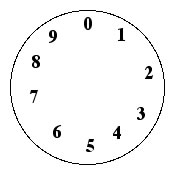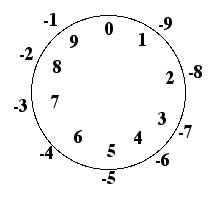
A review explanation of arithmetic Modulo 10 (or at least part of it).

First, you need to think about a clock that has the numbers 0-9 on it. This is a mod-10 clock. These are the only numbers we're working with when we do calculations mod 10--so all of the answers are one of the numbers on the clock.
Every integer has a number on the clock that corresponds to it. If you have a number 10 or greater, you can just count your way around clockwise until you get to that number. A shortcut is to just use the last digit (the ones digit) of the number. This shortcut works because every time you get to 10 or 20 or 30 you get back to 0 if you are counting around the clock. If you're working with a different mod number (and therefore a different clock) then you can't use the last-digit shortcut.
Negative numbers are a bit trickier. You still only have to work with the ones digit (-10, -20 etc still land on 0), but with negative numbers you are counting counter-clockwise around the clock.

If you had to use negative numbers a lot, though, you could figure out how to convert pretty fast, I bet, because you can do it by adding 10. For example: -8+10 ≡2, and -8 ≡2 mod 10.
When you add positive numbers, you are just adding and counting around the clock in the clockwise direction. You can use the shortcut of adding normally, and just taking the last digit. For example, to find 8+4, you could count around the clock: 9, 0, 1, 2; or you could add 8+4 ≡12 ≡2. Either way you get the answer 8+4 ≡2 mod 10.
When you multiply positive numbers, you can do exactly the same thing. So, doing 3x8 the slow way, you would do 8+8+8, and you would count around until you found the answer. You could also use the addition trick and say 8+8 ≡16 ≡6 mod 10, so 8+8+8 ≡6+8 ≡14 ≡4 mod 10. The fastest way is to do 3x8 ≡24 ≡4 mod 10. The trick of doing the multiplication normally and then just keeping the ones digit works for multiplication too.
Subtracting is trickier, because sometimes you get negative numbers and negative mods are tricky. Here are 3 ways to do it:
Dividing: We're going to do dividing as missing number multiplication, so instead of looking for 7/3, we're going to solve 3*N ≡7. For this you need to know the multiplication table pretty well. If you don't, then a good strategy is to just write out the 3's row of the multiplication table for the digits on the mod clock (in this case 0-9):
| * mod 10 | 0 | 1 | 2 | 3 | 4 | 5 | 6 | 7 | 8 | 9 |
| 3 | 0 | 3 | 6 | 9 | 2 | 5 | 8 | 1 | 4 | 7 |
Look along the second row to find 3*9 ≡7, so N ≡9.
Other mods: Modular arithmetic with other mod numbers is similar, except that instead of using the "drop the tens digit" trick, you have to subtract the mod number until you get down as small as possible.
For example, in Mod 7, the only numbers on the clock would be 0, 1, 2, 3, 4, 5, 6. Then to add and subtract and multiply, you can either make yourself a clock and count, or you can subtract off 7 a bunch of times until you get down to the number you want.
Examples (mod 7):
4+6 ≡10-7 ≡3 (mod 7)
4*6 ≡24-7 ≡17-7 ≡10-7 ≡3 (mod 7)
For the multiplication problem, you can also subtract off a convenitent multiple of 7:
4*6 ≡24-21 ≡3 (mod 7)
Or, you can long divide 24 by 7 which gives you a remainder of 3.
For subtraction, remember that 0 ≡7:
2-5 ≡0-3 ≡7-3≡4 (mod 7)